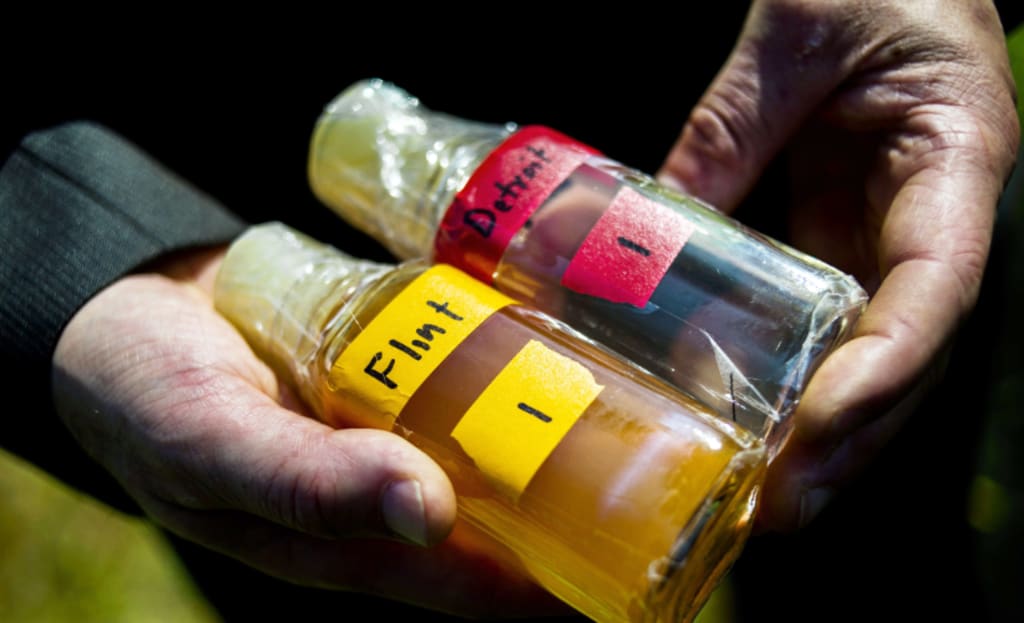The Flint Water Crisis
The Issues Resulting From The City of Flint’s Participation with the Karegnondi Water Authority

On March 25, 2013, the Flint City Council approved a deal to purchase 16 million gallons of water per day from the Karegnondi Water Authority (KWA), sourced from Lake Huron. This move broke Flint away from a nearly 40 year deal with the Detroit Water and Sewage Department (DWSD). There are many reasons to believe that the decision by the city of Flint to sign a deal with the KWA was short sighted, inconsiderate of Flint’s residents and ultimately detrimental to the city as a whole. Many of the problems leading up to Flint participating with the KWA are largely an issue of widespread structural racism and, too often, blatant disregard for the citizens of Flint, a majority African-American. In light of the elaborate and reckless exploitation of Flint’s residents through strategic racism, it is clear that the main reason Flint’s deal with the KWA was not made in the best interest of its residents is a lack of legitimate financing (or rather, shady financing) and politics taking precedence over economics at all levels of management by members of the KWA. Similar dilemma’s plagued the Department of Environmental Quality (DEQ), the MI State Treasury, and even various Emergency Managers (EMs) who had been brought in precisely to help find solutions to such problems. Flint’s participation with the KWA would only serve to increase the already high water bill for Flint’s residents, as major water waste forced them to pay for more than was ever consumed, at a higher average cost. Flint’s residents were additionally served the bill for expensive repairs necessary to make Flint’s in-house water treatment plant operational, although only temporarily.
Financial Problems
The dilemma of Flint’s financing in regards to its participation with KWA can be broken down into three main parts:
- The city of Flint’s obligation to finance improvements to its water treatment plant, as a result of the decision to participate with KWA.
- The manipulation of rules governing bond financing that would allow Flint to spend money it did not have.
- The failure of Flint to address the root problem of overly wasteful and expensive infrastructure, with the majority of water lines being severely dilapidated.
Improving the Flint Water Treatment Plant
While Flint had been receiving treated water from the DWSD since 1967, the city had a back-up water treatment plant that could be used to treat water from the Flint River in the case of an emergency. In April of 2014, Flint effectively cut ties with the DWSD and opted to use the city’s own water treatment plant to provide treated water from the Flint River until construction could be finished on the KWA pipeline, slated to be done in 2016. The total estimated cost of improvements for the water treatment plant was $61 million with the bare minimum needed to make the plant operational closer to $25 million. At the termination of their contract, Flint was paying the DWSD $12 million annually for all water needs but this budget surplus would prove to fall much too short of covering the necessary costs of upgrading the water treatment plant and honoring their commitment to the KWA.
Shady Bond Financing
In April of 2013, the DWSD made a final counter offer to Flint, as revealed in an email from Jim Fausone to the sitting Michigan Treasurer, Andy Dillon: “This proposal saves Flint/Genesee essentially 50% TODAY and 20% when compared to KWA over 30 years.” Jim Wrote, “If the decision is about economics or engineering, I don’t see how F/G proceeds with KWA.”
Although the DWSD’s offer was attractive because it provided Flint a workable alternative to obtain financing that the distressed City would find difficult to obtain elsewhere, Flint turned a deaf ear. This left the city, legally restricted by how much debt it could take on, with an impossible task of paying for their 30% share of the $285 million KWA project. In order to circumvent the debt limit and allow the city to issue bonds to finance the project, Flint officials exploited a legal loophole in the form of an Administrative Consent Order (ACO). An ACO is an agreement with a regulatory body to pay for damages caused by a statutory violation and in the case of Flint, a minor violation was all that was needed to justify the issuance of bonds to finance the entire project. Because obtaining an ACO was essential to continuing construction of the KWA project, Flint fished for violations that might warrant an ACO, settling on an inexpensive problem with a lagoon at the water treatment plant. Although the DWSD had made multiple offers to provide interim water to Flint until the KWA pipeline was constructed, having already fulfilled their commitment, Flint was able to leverage the situation as a need to refurbish the treatment plant that could sanitize the raw water coming directly off the Flint River. The ACO to update the water treatment plant was then used to issue bonds that would cover the $85 million needed to finish construction on the KWA pipeline.
Aging Infrastructure
Flint’s failing infrastructure required that the city purchase nearly twice the amount of water that was actually needed from the DWSD, to account for 40-50% of total water being lost in transmission. These increasing water bills would continue to be shouldered by Flint's citizens, regardless of where Flint bought its water from. In May of 2012, Flint turned down projects to improve the city’s infrastructure, even though Flint would have received a loan forgiveness of up to 50% because of its distressed city status. Flint declined these projects, claiming that due to the current financial situation in Flint, it was understood that it would not be feasible to pursue the bonding necessary to complete these projects. When Flint could not secure the funding to fix this root issue, the city found it possible to secure the bonds needed to finance their $85 million share of the new KWA project.
Was the KWA Really a Better Alternative?
There are a number of reasons to believe that a KWA pipeline from Lake Huron would be an improvement on Flint’s growing water crisis, rather than a contributor to it. The most credible claim is that the DWSD was a corrupt organization that charged unfair prices. In 1963, Flint took the steps to laying their own pipeline from Lake Huron but political corruption destroyed local trust in the project and the DWSD began construction of their own pipeline, signing a thirty year contract with Flint in June of 1964. Jeff Wright, CEO of the KWA, claimed that Detroit was then able to “charge whatever Detroit felt like charging for drinking water, and our community was forced to pay whatever it cost.” Wright asserted that the DWSD was corrupt and unreliable, all the while gouging Flint with extreme prices. From 2002 to 2015, the cost of DWSD water rose by an average annual rate of 11.18%, from $8.01 to $31.78 per MCF.
While these figures and claims are factual, the DWSD is subject to state laws, stringent regulations and is forbidden from charging a profit, only being able to charge wholesale costs, plus the cost of service. While these increased costs did help contribute to Flint’s problems, during this same time frame Flint increased its own retail price to citizens by an annual rate of 23.7%, more than twice the annual increase billed by the DWSD. Flint was exacerbating its own crisis and placing the blame on the DWSD in order to turn public sentiment in favor of a KWA pipeline. Days after Flint City Council voted to join the KWA, Treasury spokesman Caleb Buhs announced that the project would save Flint at least $100 million over the next 25 years, possibly even as much as $300 million. Even if accurate, such savings would have quickly been eaten up by the cost of simply updating and maintaining the water treatment plant, let alone paying for the increasing amount of water lost in transmission.
Economic Security
In reaction to a long history of costly and increasing water rates, many of Flint’s wealthier residents have opted to move into the less expensive neighboring communities, leaving the city’s poorer and less mobile citizens to pay the difference. The remaining population, a disproportionate majority African American, are financially unable to join the groves of wealthier residents fleeing into the suburbs. Flint’s unemployment and poverty rates are currently double the national average and are directly correlated with increased social and economic isolation, leading to a constantly decreasing level of mobility for Flint’s remaining citizens. The exploitation of these citizens highlights the years of systematic racism that has lambasted Flint’s minorities and the complex web of systemic racism that has been employed by Flint’s city leaders, in the pursuit of personal gain. In order to alleviate the burden on Flint’s remaining residents, the city must introduce higher paying jobs that will get more money into the pockets of its impoverished residents. One such possibility to create jobs for Flint’s unemployed is to invest in repairing and upgrading the city’s failing water system, which will contribute to the betterment of Flint on all fronts.
Flint’s Infrastructure
Whether or not Flint’s participation with the KWA project is ultimately more expensive than staying with the DWSD matters little as long as poor infrastructure and a wasteful water system continue to plague the city. The same rusty and corroded pipes that are losing nearly half of the water Flint pumps in are also responsible for the poisoning of a city and numerous deaths linked to Legionnaires disease. Flint’s failing water system certainly poses a huge financial burden but an even greater public health concern for all of the citizens it services. It is therefore necessary to invest in replacing the rust and lead filled water lines. This should have been done using the money that was collected to finance the KWA project and would have further benefited Flint by creating new jobs and putting money right back into the City. Learning from history, rather than being doomed to repeat it, city leaders around the nation can look to Flint’s plight and treat themselves to a very important lesson, taught at Flint’s expense. It is prudent to confront a problem while still manageable rather than cover it up and wait until it has become a task almost too great to conquer.






Comments (1)
Very insightful.